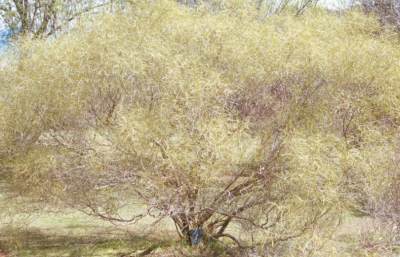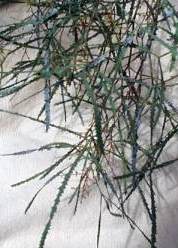Searsia erosa
Searsia erosa (Thunb.) Moffett
Family: Anacardiaceae
Common names: Broom karee, Besembos
SA Tree No: 383
Introduction
The Free State is a haven for many different plant species, one of the most interesting in the family Anacardiaceae being Searsia erosa and it grows well in the garden. Its large, soft, yellow-green shape stands out in the landscape. Many Searsia species, either shrubs or trees, are popular garden plants. Their gene pool is large and hybridization (cross pollination) takes place easily.

Description
Description
This much-branched, evergreen shrub or small tree grows to about 4 m. in height, but spreads to about 9 m across. It is fairly fast growing and has brown bark. The trifoliate leaves are very distinctive. The leaflets are very long (up to 130 mm) and narrow (3 mm wide). They usually have toothed, jagged margins which look as if they have been gnawed, giving rise to the specific name. Leaves are attached to the stem by a petiole which is up to 30 mm long, but the leaflets are sessile. The leaflets appear leathery, hairless and sticky in texture, and olive-green or yellowish green in colour, with paler undersides. The midribs are prominent and crushed leaves often emit a strong turpentine or resinous odour.
Small, white or greenish yellow flowers, are borne in loose, slender sprays and appear in early summer from October to December. They are followed by yellowish, sometimes light brown, hairless and shinyfruits (drupes) from January to April.

Conservation Status
Status
Searsia erosa is not threatened nor endangered.
Distribution and habitat
Distribution description
It occurs in karroid areas of the Cape provinces, Free State and Lesotho, usually in large numbers on rocky koppies (hills).
Derivation of name and historical aspects
History
Searsia was named after Paul B. Sears (1891-1990) who was head of the Yale School of Botany, and erosa (Latin) refers to the leaf margins which are toothed or look gnawed.
Most of the species grown in southern Africa, belonging to the genus Rhus, have been placed in Searsia. There are about 91 taxa in southern Africa. Searsia are deciduous or evergreen shrubs and trees, armed or unarmed suffrutices, shrub or trees, and stems and branches have prominent lenticels. Leaves of this genus are compound with 3 leaflets (trifoliolate).
Ecology
Ecology
Bees and other insects pollinate the flowers. Birds eat the ripefruits. Searsia erosa can withstand harsh environmental conditions such as drought and frost.
Uses
Use
This plant is not grazed, but is good for conserving soil and preventing erosion. Branches as well as leaves can be used for thatching and making brooms, hence its common name. The plant is a good garden subject in harsh environments and is sometimes used for hedges. It is said to feature in rainmaking ceremonies in Lesotho (Palgrave1981) and various parts are used to treat diarrhoea in both man and cattle.
Growing Searsia erosa
Grow
Searsia erosa has delicate, airy foliage. It can be grown in the garden as a soft, screening plant or hedge and it is attractive enough to use as a focal point in gardens where it grows well. It can be replaced in the garden by S. tenuinervis, in areas where the latter grows.
Searsia erosa survives extremes of temperature and thrives in gardens where temperatures soar to 42ºC in summer and plunge to -10ºC in winter. It grows well on stony and gravel soil as these are well drained. Avoid waterlogged soils with poor drainage.
This species grows easily from seed, if fresh, unparasitized seed can be found. Before planting the seed, place it in water. Discard all seeds that float to the surface, as they will not germinate. Rub off all fleshy bits from the remaining seed and dry the seeds in a sunny place. Then plant them in a mixture of gravel, loam and river sand. Only lightly cover the seeds and keep them moist, but never too damp. Seeds should start germinating about 8 weeks after sowing. Prick them out into individual bags when they have 4 leaves. Once plants are 0.5 m high they are ready to be planted out in the garden.
References
- MOFFETT, R.O. 2007. Name changes in the Old World Rhus and recognition of Searsia (Anacardiaceae). Bothalia 37(2):165-175
- ACOCKS, J.P.H. 1988. Veld types of South Africa, edn 3. Memoirs of the Botanical Survey of South Africa No. 57.
- VAN WYK, B. & VAN WYK, P. 1997. Field guide to trees of southern Africa. Struik, Cape Town.
- PALMER, E. 1977. A field guide to trees of southern Africa. Collins, London & Johannesburg.
- COATS PALGRAVE, K. 1981. Trees of southern Africa, edn 2. Struik, Cape Town.
- LUMLEY, M. J. & OLIVER, I. B. 1986. Cultivation of Rhus erosa and Tarchonanthus camphoratus. Veld & Flora 72: 112, 113.
- MOFFETT, R.O. 1993. Anacardiaceae: Rhus. Flora of southern Africa, Vol. 19, Part 3, Fascicle 1, National Botanical Institute, Pretoria.
Credits
Peter Gavhi
Free State National Botanical Garden
With additions by Yvonne Reynolds
October 2002
Updated July 2008
Plant Attributes:
Plant Type: Shrub, Tree
SA Distribution:
Soil type:
Flowering season: Early Summer
PH:
Flower colour: Green
Aspect: Full Sun
Gardening skill: Easy
Special Features:
Horticultural zones









Rate this article
Article well written and informative
Rate this plant
Is this an interesting plant?
Login to add your Comment
Back to topNot registered yet? Click here to register.